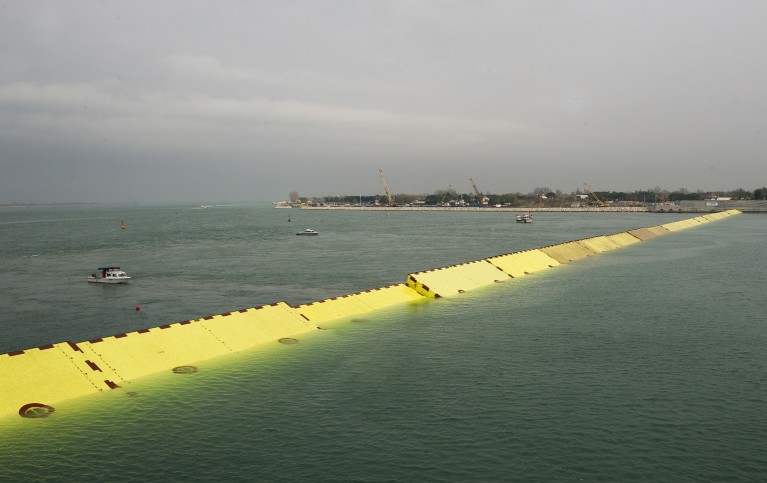
Some of the mobile gates of the Experimental Electromechanical Module (Mose) emerge during technical tests at the 'Bocca di Porto' at Venice's Lido. The system became operational in October 2020. Credit: Luca Zanon/Corbis via Getty Images.
Now in its fourth year of operation, the Venice system of mobile barriers has proven very effective in safeguarding Venice from acqua alta, the high tides in the lagoon that used to periodically flood the city. MOSE (Modulo Sperimentale Elettromeccanico) barriers, that are lifted from the seabed to stop water from the Adriatic Sea from entering the lagoon, have been raised 31 times since October. In the three previous autumn-to-summer cycles, they were used fewer than 20 times. With predicted a steady rise of the Adriatic Sea sea level, some experts are concerned that MOSE closures will become increasingly frequent, and that this may have an impact on the delicate lagoon ecosystem.
Over the past 60 years, tides exceeding 1.1 metres (the level above which MOSE is activated) have become more frequent. According to the city’s Tide Study Center, there were 30 such high tides between 1870 and 1949, compared to 76 in the last 9 years alone. Some projections (not yet peer-reviewed) indicate that by the end of the century, in a climate scenario with no mitigation effort, MOSE would be activated and the lagoon would be closed for approximately 260 days per year. The lagoon’s water temperature would surpass 30°C for more than four months, leading to an increase in marine heat waves, and the average water renewal time would triple.Fabio Pranovi, Professor of Environmental Sciences at Venice’s Ca’ Foscari University, says that in some areas of the lagoon the water exchange time is already above 11 days. Further increases will affect water and air quality, especially in warm periods when most decomposition occurs. Nutrients, like nitrogen and phosphorous from the drainage basin, could accumulate and spur the production of algae, causing eutrophication.
This is not a new problem for Venice. At the end of the 80s, algal build-up was so high in the lagoon that authorities were at a loss. Since then, the quality of the water discharged into the lagoon has improved significantly because of increased treatment, but mass fish deaths still occurred in Venice between 2013 and 2015 due to algae. Luca Zaggia, a researcher at the Italian National Research Council’s Institute of Geosciences and Earth Resources, fears that algae growth could worsen again under more frequent closures.
A spokesperson for Consorzio Venezia Nuova (CVN), the public consortium that manages MOSE, told Nature Italy that the alternative would have been the use of permanent structures at the port entrances that would be active all the time, while MOSE barriers are only active during high water events, which are generally accompanied by wave and wind that facilitate water mixing.
Another potential problem, which emerged in a University of Padua study, is that the MOSE prevents the salt marshes from being flooded during high waters. This limits the amount of sediment that accumulates on marshes, compromising their ability to compensates for sea-level rise by growing vertically. “The loss of the salt marshes, that are an important habitat for many species, could have an impact on biodiversity” said Zaggia.
The CVN spokesperson notes that while MOSE is designed to maintain water level below 110 cm, most salt marshes are lower than 70 cm, so they will still be flooded regularly, and the reduced surface sedimentation would affect only a small portion of the higher ones.
Another problem, says Zaggia, is that the MOSE could change the circulation of fine sediments from the sea that are essential for the morphology of the lagoon. A local research project called Venezia2021 analysed satellite data and found that, in addition to sand made of larger grains, fine sea sediments are transported by the flood tide currents towards the lagoon during storms, especially with northeasterly winds. He notes that structures built more than a century ago at the port entrances are already preventing the entry of such sediments, and MOSE closures could make the problem worse. Zaggia suggests building a sediment bypass, essentially an undersea tunnel equipped with pumps that would drive sediments towards the lagoon, similar to the one built at the Tweed River in Queensland, Australia.
CVN responds that the erosion in the lagoon is primarily caused by fine sediments being lifted by waves in shallow areas and being carried by tides towards the sea. Without the MOSE system maintaining lower water levels during extreme high tides, they claim, this loss would actually be higher.
A more frequent closure of the lagoon would bring about profound changes in its structure and function, transforming it into either a coastal lake or a network of smaller lakes, according to Georg Umgiesser, a CNR ISMAR researcher who has published an article on the topic. Umgiesser recommends studying other coastal lakes, intermittently closed-and-open lakes and lagoons along the warmer coastlines of the Mediterranean, South America, and Oceania. “Understanding the nuances of these environments will provide crucial insights into how a lagoon might function under altered conditions,” he says.
